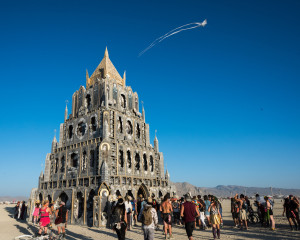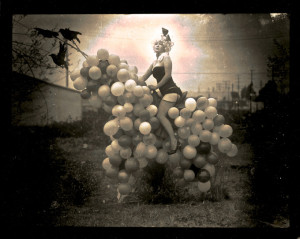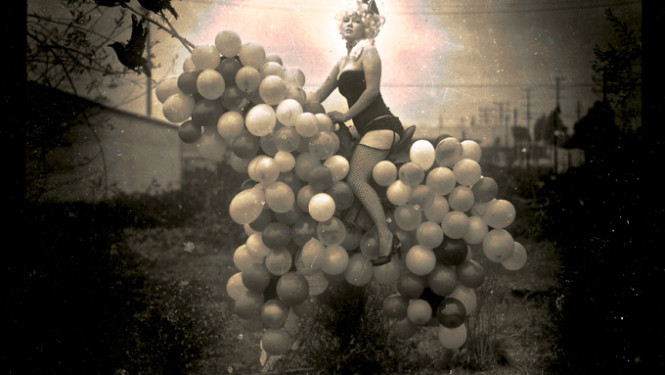
Walking across the open playa near sunset, I was caught in an inconstant dust storm that would block the whole world out for minutes at a time, then suddenly part and open up, allowing a distant glimmer of the strange and surreal structures dotting the desert landscape.
This was the first time I saw the Totem of Confessions: when it appeared before me, a tower of impossible images in black and white, then vanished again when the world disappeared in dust.
The Petaluma studio of Mike Garlington and Natalia Bertotti is just as variable and changing as the playa landscape, as they constantly move and rearrange both finished pieces and in-progress designs on a weekly basis. Their credo is to do whatever inspiration calls them towards at the moment – but working like that comes with a cost.
“We’re constantly having to clean up the studio because everything moves so much, and we need a clean environment to work in,” they say. “Honestly, art is 90% sweeping up.”
The day I visit, a large crew photo of the Totem of Confessions was posted on a wall next to a concept draft of their next architectural project: the Spire of Babel, which will debut in Virginia in 2017, and which will be used as the prototype for “The Chapel of Babel,” to appear at a future Burning Man. A few meters away a dressmaker’s dummy stands alone, with the beginning of what will be Garlington and Bertotti’s next project, to be displayed at Art Basel: a pair of dresses which, when finished, will be as much baroque decoration as clothing, to be worn by the same model. It’s dress making turned into sculpture, turned into photography.
The magical and bizarre black and white photographs which circle the rest of the warehouse studio are the work Garlington is best known for, and represent that blurring of boundaries between art forms.
“With our photos, we’re building sculptures. Even just a person in an outfit, every created backdrop becomes a sculpture in a sense. So first we build it, even if it’s just out of cardboard and tape, and then we photograph it,” Garlington says.
It may be hard to believe, but everything you see in a Garlington photograph is really in the frame. “We are using Photoshop now, and it is very tempting to start putting on third arms and eyes, but so far everything is you see is really there,” Garlington says. Often that makes for novel and interesting challenges.

“This picture,” he said, “is called ‘Balloon Horse,’ because obviously … and what happened was, I had the model here, and asked her what she liked, and she said ‘horses,’ and I said ‘how about a balloon horse?’ And then, as soon as I said it, I was terrified, because oh, now I have to actually do that. So we put together this set of balloons to look like the shape of a horse she was riding, and I spent all this time to make it look like it was actually floating above the ground.”

That kind of spontaneity is what Garlington and Bertotti enjoy most about their work, which only truly comes together through the process of collaboration.
“Going from the schematic to what it is, is really the process of defining the meaning of the piece,” Bertotti says. “The process of figuring out what works can change the whole nature of the piece, and you say ‘let’s try that’ and suddenly you have a whole additional layer that adds a whole new component of meaning.”
“A lot of this (artwork) just comes from adventures,” she adds. “That one on the back wall, it’s just like: as we go places, let’s see what pictures we can take, make some masks and sculptures out of cardboard.”
Bertotti calls their work “a whimsical veil between reality and imagination,” which Garlington agrees with heartily. But for all the whimsy and the play and the spontaneity, Garlington also embodies a very traditional kind of artist – one who spent endless hours alone in a dark room developing his craft. All this spontaneity and play is only possible because he spent so long teaching his fingers to work.
“I grew up in a black-and-white photographic family, my mother and father were both photographers and printers,” he said. “I didn’t go to college, photography was my college. It was 12 years to learn to print emotionally” – by which he means how to “have a conversation with the light” in developing pictures so that any composition can be made more vibrant and engaging – “and then I started taking pictures, and that was another 10 years, and finding out that I was putting sculpturals in pictures.”
At that point, with the black and white photo businesses tanking, he got a gig with Burning Man’s DPW in ’07 and went out to work on a David Best temple. “I couldn’t even use a saw,” he remembers. “I was afraid to. But the DPW – there they were. I drank the Kool-Aid immediately. That place gave me the ability and the confidence to go the next level.”
He practiced his art there too, taking pictures of his fellow DPW crew and “slathering” them on the sides of the fluffer vans, and his work eventually got him attention and commissions, including working on Laura Kimpton’s “Ego,” which proved to be a big break, and then the 2013’s “Photo Chapel.”
He began partnering with Bertotti in 2013, “reaching out,” he said, after a long period of solitary practice to develop and hone his craft and aesthetic. It is only now, after all that work, that he is able to simply play at this level. There is incredible expertise that is now devoted to a non-benign whimsy.
The influence of religion in Garlington’s work is overwhelming – the structures are based on Medieval cathedrals and chapels, the imagery often iconographic – even if it is in no way reverent (as anyone who saw “the violation of the nun” in the Totem of Confessions can attest). In many ways religion is also a veil between reality and imagination, and has spent thousands of years honing its own craft, and so it’s an influence he eagerly seeks out, making a point of visiting religious structures and art whenever he is in Europe, to learn from the Master.
“For years religion has sort of repressed and fucked with people, so now it’s my turn,” Garlington says, laughing. “And I can say that, but I can also say: when I go to Europe and I go into a church, the beauty of it … the beauty just kills me. The horror, but the beauty. The horror and the wonder.”
“The horror and the wonder,” Bertotti repeats back. It’s clearly a phrase they’ve used before.
“Looking at these images, thinking of this history, there’s so much horror in religion, so much blood, so much terrible stuff. But also the exact opposite of that feeling,” Garlington says. “We were trying to think of the opposite of horror, and we eventually thought: it’s wonder. That’s what it is. We just bought a Bosch book, and it just knocks you out.”
It’s the ability of Garlington’s art to encompass both those extremes that most inspires me: the images may be fantastical in their beauty, but in their capacity to encompass the totality of the human experience they are utterly realistic. They are a map to the psyche, directing us to the farthest reaches of our capacity to experience, yes, horror and wonder. Awe and terror. And – as portraits – new expressions of our possible selves.
When I ask what admirers of his work like me can do to support him, Garlington and Bertotti say come and see them. They are in their studio almost every day, often beginning early in the morning, making art. Appointments can be set by hitting them up on Facebook. Their studio has prints for sale, and they will take portrait commissions “on a sliding scale.” (I get the sense they’re more excited to have people come and be portrait subjects than they are about getting paid, but come on, somebody pay them.)
I press, though: what do artists like you need? What, besides just selling more work, would be good for you?
He encourages people to buy original art, instead of reproductions, and wishes there were more spaces like Burning Man where people can experiment the way he has (“Nobody else in the world was going to let me build a surreal cathedral including a nun getting violated in their public space, let alone help support it, no matter how beautiful I could make it,” he says laughing).
But ultimately he just isn’t interested in talking about the financial side of the art world. Art simply isn’t reducible to money for him.
“I’m stuck making art for the next 20 ears, with or without commissions, even if it means living as a hudredaire,” he says. “Luckily I have a few jobs now, but I mean, I’m still a struggling artist. Which I kind of like in a sense, actually, because I don’t know, if I had money, if I’d have done it all myself. I might have had someone else do it and then lose that experience, that joy, of learning and failing and then making it better.”
There’s always a next step for Garlington, and it always involved getting callouses on your hands. You just never see them in the final picture. You see an impossible vision. You see the boundaries of your humanity. You see the whimsical side of horror and wonder. He makes it look so easy.
Mike Garlington and Natalia Bertotti’s studio is at 224 Weller Street in Petaluma, CA. They can be reached on Facebook, and encourage you to connect with them.




fantastic work! will come by the studio
Report comment
Thanks so much for checking out this artist. I was wondering……
Report comment
Comments are closed.